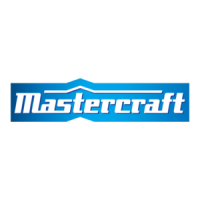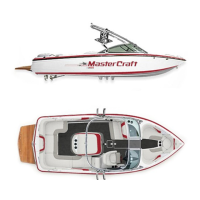Do you have a question about the MasterCraft X-Star 2008 and is the answer not in the manual?
Defines safety alert symbol, DANGER, WARNING, and CAUTION to communicate hazards.
Warns about carbon monoxide gas and safe operation of safety switches and engine.
Safety advice for launching, battery handling, and engine compartment operations.
Emphasizes operator responsibility, using common sense, and understanding controls is critical.
Lists USCG-approved equipment like mufflers, flame arrestors, ventilation, horn, and lighting.
Highlights dangers of improper operation, alcohol, drugs, and importance of safety lanyard.
Warns about towing limits, platform use during operation (CO hazard), and checking warning labels.
Emphasizes turning off engine when anchoring and avoiding stern exhaust areas for CO safety.
Strongly encourages PFD use and warns that overloading causes instability and sinking.
Details rules for meeting, crossing, and overtaking vessels to avoid collisions.
Details right-of-way for various vessel encounters and special navigation situations.
Details tachometer, hourmeter, air temp, clock, and alarms (VOLT, OIL, TEMP, TRAN).
Details oil pressure gauge readings and warns about severe engine damage from overheating.
Details the function and importance of the emergency engine safety switch (lanyard).
Explains trim tab system operation, special conditions, and cautions for use.
Details the two-position switch for synchronizing engines (280 STS/SST only).
Warns about gasoline flammability, explosiveness, and the need to avoid sparks and flames.
Details essential checks before launching, including fuel, steering, and safety equipment.
Highlights the first 50 hours for engine/transmission wear-in and proper operation.
Covers oil level, gauge checks, varying speed, planing, and continuous operation after break-in.
Warns about oil issues and advises gradual engine warm-up.
Details pre-start checks, safety tether attachment, and the engine starting procedure.
Provides cautions regarding starter motor use, engine warm-up, and starting in gear.
Details forward, reverse shifting, and stopping procedures, emphasizing neutral position.
Warns against overloading and stresses proper weight distribution for performance and safety.
Warns against simulating professional maneuvers; potential for serious injury or damage.
Details using lifting eyes and slings with appropriate capacity and care.
Recommends break-in services like lubricating starter gear and checking fuel filter.
Details checks before use, quarterly (50-hr), and annual (100-hr) maintenance tasks.
Step-by-step guide to checking battery terminals for cleanliness and tightness.
Warns about dangerous battery electrolyte fluid and the need for immediate medical attention if exposed.
Instructs to check the dripless shaft log for dripping after operation and seek dealer service if needed.
Details visual and olfactory checks for gasoline leaks in the fuel system.
Details checking voltmeter readings during starting and the function of the low-voltage battery alarm.
Warns about hydrogen gas during charging and cautions against jump-starting batteries.
Provides steps for lubricating the starter bendix with waterproof grease.
Guides on running the bilge blower and inspecting the bilge area for fuel or odors.
Recommends professional winterization due to complexity and risk of extreme engine damage.
Covers checking drain plugs, hoses, impeller, spark plugs, fluids, and clamps.
Details how to check for propeller blade variance and when to seek dealer service.
Covers throttle/shifting, steering, and vibration issues with possible causes and solutions.
Defines safety alert symbol, DANGER, WARNING, and CAUTION to communicate hazards.
Warns about carbon monoxide gas and safe operation of safety switches and engine.
Safety advice for launching, battery handling, and engine compartment operations.
Emphasizes operator responsibility, using common sense, and understanding controls is critical.
Lists USCG-approved equipment like mufflers, flame arrestors, ventilation, horn, and lighting.
Highlights dangers of improper operation, alcohol, drugs, and importance of safety lanyard.
Warns about towing limits, platform use during operation (CO hazard), and checking warning labels.
Emphasizes turning off engine when anchoring and avoiding stern exhaust areas for CO safety.
Strongly encourages PFD use and warns that overloading causes instability and sinking.
Details rules for meeting, crossing, and overtaking vessels to avoid collisions.
Details right-of-way for various vessel encounters and special navigation situations.
Details tachometer, hourmeter, air temp, clock, and alarms (VOLT, OIL, TEMP, TRAN).
Details oil pressure gauge readings and warns about severe engine damage from overheating.
Details the function and importance of the emergency engine safety switch (lanyard).
Explains trim tab system operation, special conditions, and cautions for use.
Details the two-position switch for synchronizing engines (280 STS/SST only).
Warns about gasoline flammability, explosiveness, and the need to avoid sparks and flames.
Details essential checks before launching, including fuel, steering, and safety equipment.
Highlights the first 50 hours for engine/transmission wear-in and proper operation.
Covers oil level, gauge checks, varying speed, planing, and continuous operation after break-in.
Warns about oil issues and advises gradual engine warm-up.
Details pre-start checks, safety tether attachment, and the engine starting procedure.
Provides cautions regarding starter motor use, engine warm-up, and starting in gear.
Details forward, reverse shifting, and stopping procedures, emphasizing neutral position.
Warns against overloading and stresses proper weight distribution for performance and safety.
Warns against simulating professional maneuvers; potential for serious injury or damage.
Details using lifting eyes and slings with appropriate capacity and care.
Recommends break-in services like lubricating starter gear and checking fuel filter.
Details checks before use, quarterly (50-hr), and annual (100-hr) maintenance tasks.
Step-by-step guide to checking battery terminals for cleanliness and tightness.
Warns about dangerous battery electrolyte fluid and the need for immediate medical attention if exposed.
Instructs to check the dripless shaft log for dripping after operation and seek dealer service if needed.
Details visual and olfactory checks for gasoline leaks in the fuel system.
Details checking voltmeter readings during starting and the function of the low-voltage battery alarm.
Warns about hydrogen gas during charging and cautions against jump-starting batteries.
Provides steps for lubricating the starter bendix with waterproof grease.
Guides on running the bilge blower and inspecting the bilge area for fuel or odors.
Recommends professional winterization due to complexity and risk of extreme engine damage.
Covers checking drain plugs, hoses, impeller, spark plugs, fluids, and clamps.
Details how to check for propeller blade variance and when to seek dealer service.
Covers throttle/shifting, steering, and vibration issues with possible causes and solutions.
| Brand | MasterCraft |
|---|---|
| Model | X-Star 2008 |
| Category | Boat |
| Language | English |












